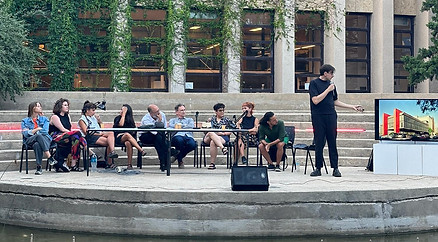ARCHITECTURE
ACADEMIC
TRIP
ATLAS DE PAISAJES CULTURALES
The Architecture Trip is an academic experience that consolidates the undergraduate training in the Facultad de Arquitectura, Diseño y Urbanismo of the Universidad de la Republica (FADU - UdelaR) of Uruguay since the second decade of the 20th century.
Initially, this trip took the form of the Grand Prix, a prize for academic excellence granted to a few outstanding and recently graduated architects. Subsequently, starting in 1947, the journey transformed into a collective experience for each generation, evolving until the creation of Architecture Travel Groups. Year after year, the structure that enables this unique academic experience in the world consolidates and adapts, resulting in an almost 80-year development. This tradition, known as the Architectural Trip, is accompanied by a Faculty Team that proposes an academic project to be carried out during the travel route. This academic project focuses on producing an Atlas of Cultural Landscapes of the Architecture Trip.
The Architecture Trip allows students to immerse themselves in various architectural and urban contexts of different cultures. They can observe and analyze the built environment, the urban planning, and the frictions between different periods and regions. The term “itinerant” refers to something or someone who travels from one place to another regularly or frequently rather than remaining in a specific place permanently. This academic proposal, Atlas of Cultural Landscapes, seeks to map cultural landscapes during the trip, challenging the traditional notion of fixed geographic and cultural boundaries. Cultural landscapes are considered an expression of the historical interaction between geography and society and, therefore, become a constantly changing canvas in which traces of the past and transformations over time become apparent. Buildings, infrastructure, traditions, and practices reflect temporal evolution and become a symbol of identity, representing the values societies share.

During the trip, students will perform as observers and documenters of the different places visited along the route. To record and archive this, the Teaching Team has chosen the Atlas as a research method and has developed a mobile app designed to be used before, during, and after the trip. The Atlas is a socio-spatial device capable of expressing the various records and experiences collected during the journey, achieving a balance between personal and cultural experiences. It is a doubly operative tool that allows us to organize information in real-time and interconnect different data through five working axes. These working axes are the guiding thread for exploring and delving into various themes and approaches. They will allow students to carry out specific work that will help them enrich their professional training or lead to further academic experiences, such as internships, research, or postgraduate studies.
WHAT DOES THE ACADEMIC TRIP IN ARCHITECTURE CONSIST OF?

#ACADEMIC PROPOSAL

#OBJETIVES

#METHOD



We gave talks in several cities about various projects and connected with local researchers to delve deeper into their hidden stories. That’s me talking about the other face of IIT campus construction.
With these new stories we generated a series of interventions. In this case, the redesign of the Fansworth House floor plan seeks to question the cultural museum phenomenon surrounding the house, which is currently discussing moving it back due to flooding.
Is it still the Fansworth house?
#TOOLS
We designed a mobile application called ATLAS, which provides a georeferenced guide of works, an itinerary, and—most importantly—the ability to add new information and works to the map. In the end, it is an operational tool capable of building a collective record of the journey. Using all this data, information, and categories, we created a website to visualize the relationships, providing a foundation for future research and field projects.
#TRIP




Team: Jorge Nudelman, Alejandro Ferraz, Soledad Cebey, Laura Acosta, Elina Rodriguez, Pablo Muñoz, Valentina Odella, Lucía Martinotti, Magdalena Fernandez, Alejandro Varela.


